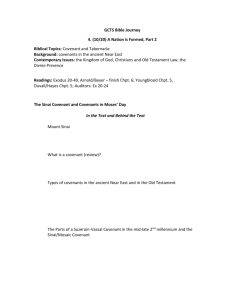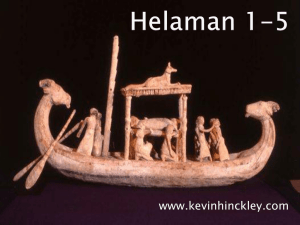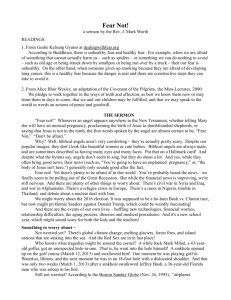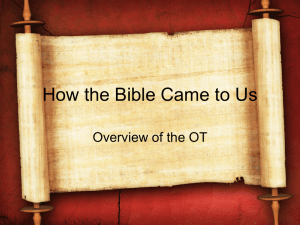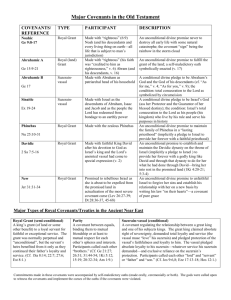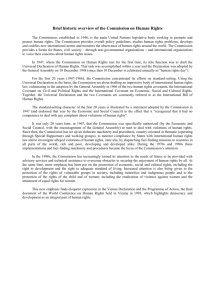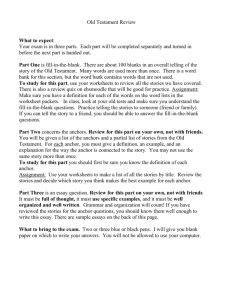Study Guide - Third Millennium Ministries
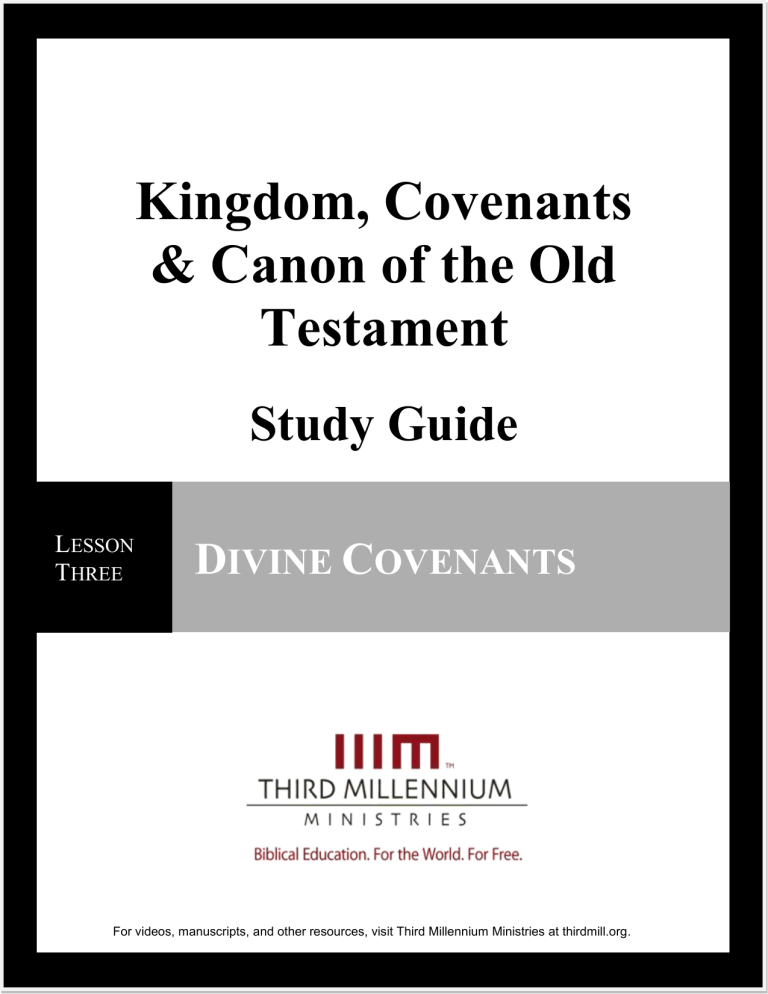
Kingdom, Covenants
& Canon of the Old
Testament
Study Guide
L
ESSON
T
HREE
D
IVINE
C
OVENANTS
© 2013 by Third Millennium Ministries
For videos, manuscripts, and other resources, visit Third Millennium Ministries at thirdmill.org.
www.thirdmill.org
2
CONTENTS
HOW TO USE THIS LESSON AND STUDY GUIDE ................................................. 3
NOTES ............................................................................................................................... 4
I. INTRODUCTION (0:28) ........................................................................................... 4
II. KINGDOM AND COVENANTS (2:42) ................................................................... 4
A. Archaeological Discoveries (3:59) ....................................................................... 4
B.
Biblical Insights (9:36) ......................................................................................... 6
III. HISTORY OF THE COVENANTS (17:05) ............................................................. 7
A.
Universal Covenants (19:15) ............................................................................... 7
1. Adam (20:25) ................................................................................................. 8
2. Noah (24:09) .................................................................................................. 9
B.
National Covenants (27:06) ............................................................................... 10
1. Abraham (27:58) .......................................................................................... 10
2. Moses (30:14) .............................................................................................. 11
3. David (32:52) ............................................................................................... 12
C.
New Covenant (35:00) ....................................................................................... 12
IV. DYNAMICS OF THE COVENANTS (39:17) ....................................................... 14
A.
Universal Covenants (42:17) ............................................................................. 15
1. Adam (42:57) ............................................................................................... 15
2. Noah (44:49) ................................................................................................ 16
B.
National Covenants (47:44) ............................................................................... 16
1. Abraham (48:32) .......................................................................................... 16
2. Moses (51:57) .............................................................................................. 18
3. David (54:04) ............................................................................................... 19
C.
New Covenant (55:55) ....................................................................................... 19
V. PEOPLE OF THE COVENANTS (1:02:01) ........................................................... 21
A.
Divisions of Humanity (1:02:48) ....................................................................... 21
1. Within Covenants (1:04:15) ......................................................................... 21
2. Included and Excluded (1:09:08) ................................................................. 23
B.
Application of Dynamics (1:12:41) ................................................................... 24
1. Unbelievers Excluded (1:14:15) .................................................................. 24
2. Unbelievers Included (1:17:11) ................................................................... 25
3. Believers Included (1:21:57) ........................................................................ 26
VI. CONCLUSION (1:28:52) ........................................................................................ 27
REVIEW QUESTIONS ................................................................................................. 28
APPLICATION QUESTIONS ...................................................................................... 33
Kingdom, Covenants and Canon of the Old Testament
Lesson 3: Divine Covenants
© 2008 by Third Millennium Ministries www.thirdmill.org
HOW TO USE THIS LESSON AND STUDY GUIDE
This study guide is designed for use in conjunction with the associated video lesson. If you do not have access to the video, the study guide will also work with the audio and/or text versions of the lesson. Additionally, the lesson and study guide are intended to be used in a learning community, but they also can be used for individual study if necessary.
Before you watch the lesson o Prepare — Complete any recommended readings. o Schedule viewing
— In the Notes section of the study guide, the lesson has been divided into sections that correspond to the video. Using the time codes found in parentheses beside each major division, determine where to begin and end your viewing session. IIIM lessons are densely packed with information, so you may also want to schedule breaks. Breaks should be scheduled at major divisions.
While you are watching the lesson o Take notes
— The Notes section of the study guide contains a basic outline of the lesson, including the time codes for the beginning of each section and key notes to guide you through the information. Many of the main ideas are already summarized, but make sure to supplement these with your own notes. You should also add supporting details that will help you to remember, describe, and defend the main ideas.
o Record comments and questions — As you watch the video, you may have comments and/or questions on what you are learning. Use the margins to record your comments and questions so that you can share these with the group following the viewing session. o Pause/replay portions of the lesson — You may find it helpful to pause or replay the video at certain points in order to write additional notes, review difficult concepts, or discuss points of interest.
After you watch the lesson o Complete Review Questions — Review Questions are based on the basic content of the lesson. You should answer Review Questions in the space provided. These questions should be completed individually rather than in a group. o Answer/discuss Application Questions — Application Questions are questions relating the content of the lesson to Christian living, theology, and ministry. Application questions are appropriate for written assignments or as topics for group discussions. For written assignments, it is recommended that answers not exceed one page in length.
© 2013 by Third Millennium Ministries www.thirdmill.org
Notes
I.
Introduction (0:28)
II.
Kingdom and Covenants (2:42)
The term usually translated “covenant” ( berith in Hebrew) appears 287 times in the Old Testament.
A.
Archaeological Discoveries (3:59)
Discoveries from ancient cultures surrounding ancient Israel have given us many insights into the character of biblical covenants.
One of the most important discoveries is a group of writings known as
Suzerain-Vassal treaties.
© 2013 by Third Millennium Ministries www.thirdmill.org
Notes 5
Suzerain-vassal treaties were designed by kings for the administration of their kingdoms.
Royal Benevolence : Treaties were introduced by a focus on royal benevolence, the kindnesses the emperor had shown to his vassals.
Vassal Loyalty : Suzerain-vassal treaties focused on the requirement of vassal loyalty, spelling out the kinds of obedience required of the emperor’s vassals.
Consequences : Suzerain-vassal treaties drew attention to the consequences of loyalty and disloyalty from vassals.
These three central features of suzerain-vassal treaties aid our understanding of the nature of Old Testament covenants.
Kingdom, Covenants and Canon of the Old Testament
Lesson 3: Divine Covenants
© 2008 by Third Millennium Ministries www.thirdmill.org
Notes 6
B.
Biblical Insights (9:36)
One specific form of covenant in the Old Testament was the divine covenant. These are the covenants that God himself made with people.
When we look at the covenant God made with Moses, we see that it was structured in ways that resemble ancient Near Eastern suzerain-vassal treaties.
Divine Benevolence : God reminded Israel of his divine benevolence demonstrated in the way God had graciously delivered them from slavery in Egypt.
Human Loyalty
: God required his servants to be loyal, and Moses’ law spelled out many of the ways Israel was to show their loyalty.
Kingdom, Covenants and Canon of the Old Testament
Lesson 3: Divine Covenants
© 2008 by Third Millennium Ministries www.thirdmill.org
Notes 7
Consequences : Moses’ covenant entailed consequences for loyalty and disloyalty from God’s people.
Old Testament divine covenants were royal arrangements. Covenants were the means by which God ruled over his kingdom.
III.
History of the Covenants (17:05)
During each period or stage in the kingdom, God introduced covenants that addressed the particular issues that people were facing at each stage of the kingdom.
A.
Universal Covenants (19:15)
Adam and Noah represented every person from every tribe and nation.
Their experiences impacted the lives of every human being to come after them.
Kingdom, Covenants and Canon of the Old Testament
Lesson 3: Divine Covenants
© 2008 by Third Millennium Ministries www.thirdmill.org
Notes 8
1.
Adam (20:25)
The covenant with Adam appears in the creation narrative found in the Genesis 1–3.
Three pieces of evidence strongly suggest that God established a covenant with Adam as the representative of humanity.
The basic contours of divine covenants are present in
Genesis 1–3.
Hosea 6:7 compares the sinfulness of Israel with Adam’s sin in the Garden of Eden, and speaks of both as breaking covenant.
Noah’s covenant was presented as a confirmation of a previously existing covenant, namely the covenant God made with Adam.
God entered a solemn relationship with Adam who represented the entire human race; a covenant of foundations.
Kingdom, Covenants and Canon of the Old Testament
Lesson 3: Divine Covenants
© 2008 by Third Millennium Ministries www.thirdmill.org
Notes 9
The covenant with Adam laid out the parameters of humanity’s relationship with God for all time. It established the foundations of our role in his kingdom.
2.
Noah (24:09)
The covenant with Noah was:
established in the primeval period of God’s kingdom
concerned some of the most basic issues that face all of humanity
Mentioned in Genesis chapters 6 and 9.
The Noahic covenant was introduced to assure stability in the created order; it is rightly called a covenant of stability.
Kingdom, Covenants and Canon of the Old Testament
Lesson 3: Divine Covenants
© 2008 by Third Millennium Ministries www.thirdmill.org
Notes 10
God established his covenant with Noah, promising that nature would remain stable so that the human race could reach its destiny in this fallen world.
B.
National Covenants (27:06)
As the kingdom of God moved from the primeval history to the period in which God focused especially on the nation of Israel, God established three national covenants.
1.
Abraham (27:58)
We find explicit references to Abraham’s covenant in Genesis chapters 15 and 17.
The covenant with Abraham set the people of Israel apart to be
God’s special instruments in bringing his heavenly kingdom to the whole earth. This covenant can be seen as a covenant of promise.
Kingdom, Covenants and Canon of the Old Testament
Lesson 3: Divine Covenants
© 2008 by Third Millennium Ministries www.thirdmill.org
Notes 11
2.
Moses (30:14)
Moses frequently appealed to the covenant with Abraham as the basis of his own kingdom work.
The national covenant with Moses built upon and was in harmony with the national covenant that God had previously made under
Abraham.
The Mosaic covenant is recorded in Exodus 19-24. We may refer to this covenant as a covenant of law.
When the people of Israel agreed to enter this covenant, their commitment came in the form of commitment to God’s law.
Kingdom, Covenants and Canon of the Old Testament
Lesson 3: Divine Covenants
© 2008 by Third Millennium Ministries www.thirdmill.org
Notes
3.
David (32:52)
David’s covenant was built upon the previous covenant with the nation of Israel.
2 Chronicles 6:16
Psalm 89
David’s covenant promised David that his family’s line would always be Israel’s ruling dynasty. We may call David’s covenant
Israel’s covenant of kingship.
C.
New Covenant (35:00)
The Old Testament spoke of a new covenant that would come during the final stage of God’s kingdom.
Jeremiah 31
Ezekiel 37
Kingdom, Covenants and Canon of the Old Testament
Lesson 3: Divine Covenants
© 2008 by Third Millennium Ministries www.thirdmill.org
12
Notes 13
Through this new covenant in Christ, God administers his kingdom in its final stage, which we call the New Testament age. The new covenant is a covenant of fulfillment.
This covenant of fulfillment was to govern God’s people when he ended their exile and spread his kingdom to the ends of the earth.
Remembering the three phases of the kingdom in the New Testament is essential to understanding how God established the new covenant.
The new covenant will bring to fruition all of God’s purposes behind the covenant administrations in Adam, Noah, Abraham, Moses and David.
Kingdom, Covenants and Canon of the Old Testament
Lesson 3: Divine Covenants
© 2008 by Third Millennium Ministries www.thirdmill.org
Notes 14
IV.
Dynamics of the Covenants (39:17)
These emphases are not comprehensive descriptions of covenant life; they merely touch on certain highlights:
Adam’s covenant — foundational patterns
Noah’s covenant — the stability of nature
Abraham’s covenant — God’s promise
Moses’ covenant — God’s law
David’s covenant — the Davidic dynasty
The new covenant — fulfillment
The dynamics of living in covenant with God always involved:
the benevolence of God
the requirement of human loyalty
consequences for human loyalty and disloyalty
Kingdom, Covenants and Canon of the Old Testament
Lesson 3: Divine Covenants
© 2008 by Third Millennium Ministries www.thirdmill.org
Notes 15
A.
Universal Covenants (42:17)
1.
Adam (42:57)
Divine Benevolence : God showed much benevolence toward the first man and woman, even before they sinned.
Human Loyalty : God tested their loyalty with the tree of the knowledge of good and evil.
Consequences : God told Adam and Eve that they would suffer the consequences of curse if they were disloyal and ate the forbidden fruit.
What was true for Adam and Eve was true for all of their descendants as well.
Kingdom, Covenants and Canon of the Old Testament
Lesson 3: Divine Covenants
© 2008 by Third Millennium Ministries www.thirdmill.org
Notes 16
2.
Noah (44:49)
Divine Benevolence : God determined to save Noah and his family.
Human Loyalty : God commanded Noah to build the ark and gather the animals.
Consequences : Noah was faithful to God. God was pleased with
Noah’s sacrifice after the flood and blessed him with a stable world.
B.
National Covenants (47:44)
1.
Abraham (48:32)
Abraham’s covenant emphasized the promises of progeny and land for the people of Israel, but all three covenant dynamics were operative at this time.
Kingdom, Covenants and Canon of the Old Testament
Lesson 3: Divine Covenants
© 2008 by Third Millennium Ministries www.thirdmill.org
Notes 17
Divine Benevolence : God showed mercy to Abraham, forgiving him of sin, counting him as righteous, protecting him from troubles.
Human Loyalty : God required Abraham to:
leave his homeland and family and to go to a land he had never seen
walk before him and be blameless
Consequences :
The increase of Abraham’s descendants would be a consequence of loyalty.
Anyone who was not circumcised among the men of Israel would suffer the curse of being cut off from his people.
Kingdom, Covenants and Canon of the Old Testament
Lesson 3: Divine Covenants
© 2008 by Third Millennium Ministries www.thirdmill.org
Notes
2.
Moses (51:57)
The covenant with Moses stressed God’s law because it was established when God was forming the tribes of Israel into a unified nation.
Divine Benevolence : Evident in the Ten Commandments in the prologue that precedes God’s laws.
Human Loyalty : First Commandment — divine grace supported and led to the requirement of faithfulness.
Consequences : The Ten Commandments speak of the consequences of loyalty and disloyalty in Exodus 20:4-6.
Kingdom, Covenants and Canon of the Old Testament
Lesson 3: Divine Covenants
© 2008 by Third Millennium Ministries www.thirdmill.org
18
Notes 19
3.
David (54:04)
Divine Benevolence : God chose David and established him and his descendants as the permanent dynasty over Israel.
Human Loyalty : David and his sons were required to keep God’s
Law.
Consequences : If David’s sons forsook God’s laws, they would be punished severely. Great blessings would come to the sons of
David who were faithful to God.
C.
New Covenant (55:55)
Divine Benevolence : God promised to show great kindness to his exiled people as he established the new covenant.
Kingdom, Covenants and Canon of the Old Testament
Lesson 3: Divine Covenants
© 2008 by Third Millennium Ministries www.thirdmill.org
Notes 20
Human Loyalty : God does not promise to do away with his laws, and he does not exempt anyone from obeying them.
Consequences : God would bring great blessings to his people because they would keep the obligations of this covenant.
The new covenant comes into effect in three stages, following the pattern of the final phase of God’s kingdom in Christ.
Inauguration : The new covenant is inaugurated because Christ finished his earthly ministry.
Continuation
: The new covenant also depends on Christ’s continuing work as the mediator of the covenant.
Consummation : One day Christ will return and bring to completion the promises of the new covenant.
Kingdom, Covenants and Canon of the Old Testament
Lesson 3: Divine Covenants
© 2008 by Third Millennium Ministries www.thirdmill.org
Notes 21
V.
People of the Covenants (1:02:01)
A.
Divisions of Humanity (1:02:48)
1.
Within Covenants (1:04:15)
Every covenant in the Old Testament included both believers and unbelievers.
The universal covenants with Adam and Noah include all people, whether believers or unbelievers are bound to God by these covenants.
The national covenants also included believers and unbelievers.
Throughout Israel’s history, God distinguished between those who believed and those who did not within the nation of Israel.
Kingdom, Covenants and Canon of the Old Testament
Lesson 3: Divine Covenants
© 2008 by Third Millennium Ministries www.thirdmill.org
Notes 22
The promise of the new covenant is that at its fulfillment, everyone in it will be true believers.
We must remember that the kingdom of God in the new covenant is fulfilled in three developing phases.
Until Christ returns to bring full salvation, the people of the new covenant are still divided into two groups: believers and unbelievers.
New Testament writers knew that not everyone in the new covenant community was a true believer.
Until Christ returns, the church, the new covenant community, consists of both true believers and unbelievers.
Kingdom, Covenants and Canon of the Old Testament
Lesson 3: Divine Covenants
© 2008 by Third Millennium Ministries www.thirdmill.org
Notes
2.
Included and Excluded (1:09:08)
All people including Gentiles are included in the universal covenants, but Gentile nations were excluded from Israel’s national covenants.
Once God initiated the national covenants with Israel, there are actually three kinds of people in the world:
those within Israel’s covenants with God who were true believers
those within Israel’s covenants with God who were unbelievers
those who were outside of Israel’s national covenants
Now that Christ has come, those outside of the new covenant include both Jews and Gentiles who have no part in Christ or his church.
Kingdom, Covenants and Canon of the Old Testament
Lesson 3: Divine Covenants
© 2008 by Third Millennium Ministries www.thirdmill.org
23
Notes 24
B.
Application of Dynamics (1:12:41)
Both Old Testament Israelites who first read the Old Testament, and
Christians who read it now, face a similar threefold division of the human race:
those outside covenant
unbelievers in covenant
believers in covenant
1.
Unbelievers Excluded (1:14:15)
Unbelievers participate in the universal covenants with Adam and
Noah, so their lives are touched by all three dynamics of the covenants
Divine Benevolence
: All unbelievers experience God’s kindness through the mercy he shows to all people. We of ten call these blessings “common grace.”
Human Loyalty : Unbelievers outside the national covenants and the new covenant remain obligated to be loyal to their creator.
Kingdom, Covenants and Canon of the Old Testament
Lesson 3: Divine Covenants
© 2008 by Third Millennium Ministries www.thirdmill.org
Notes 25
Consequences : When Christ returns, these unbelievers will have no blessings from God. They will only suffer his eternal judgment.
2.
Unbelievers Included (1:17:11)
Unbelievers who are in the covenants with the nation of Israel and in the new covenant experience all three dynamics of the covenant:
Divine Benevolence : God shows greater mercy to unbelievers who are in an exclusive covenant with him than he does to unbelievers outside those covenants.
Human Loyalty : They have heightened requirements of loyalty because they have received greater knowledge of
God than other unbelievers have received.
Consequences : They experience many temporary blessings.
But when Christ returns, they will face eternal judgment.
Kingdom, Covenants and Canon of the Old Testament
Lesson 3: Divine Covenants
© 2008 by Third Millennium Ministries www.thirdmill.org
Notes 26
3.
Believers Included (1:21:57)
These people are the wondrously redeemed people of God destined irrevocably to share eternal life in Christ:
Divine Benevolence : Immeasurable benevolence, including the forgiveness of sins and eternal fellowship with God.
Human Loyalty : o Loyal obedience out of gratitude for what God has done for us in Christ. o Follow Scripture’s rules and regulations to test and prove their faith.
Consequences : True believers in the Old Testament and
New Testament experience the consequences of their loyalty and disloyalty: o True believers experience temporary blessings and curses from God. o When Christ returns in glory true believers will only experience the eternal blessings of God.
Kingdom, Covenants and Canon of the Old Testament
Lesson 3: Divine Covenants
© 2008 by Third Millennium Ministries www.thirdmill.org
Notes
Every passage in the Old Testament warned and encouraged its original readers to consider their status in relation to God’s covenants and we must do the same today.
Covenant dynamics apply to every kind of person living today.
VI.
Conclusion (1:28:52)
27
Kingdom, Covenants and Canon of the Old Testament
Lesson 3: Divine Covenants
© 2008 by Third Millennium Ministries www.thirdmill.org
1.
2.
Review Questions
What recent archaeological discoveries can help us understand biblical covenants?
What insights can recent archaeological discoveries give us into biblical covenants?
© 2013 by Third Millennium Ministries www.thirdmill.org
Review Questions
4.
3. How did the universal covenants move God’s kingdom purposes forward?
How did the national covenants move God’s kingdom purposes forward?
Kingdom, Covenants and Canon of the Old Testament
Lesson 3: Divine Covenants
© 2008 by Third Millennium Ministries www.thirdmill.org
29
Review Questions
6.
5. How does the new covenant move God’s kingdom purposes forward?
How are covenant dynamics expressed in the universal covenants?
Kingdom, Covenants and Canon of the Old Testament
Lesson 3: Divine Covenants
© 2008 by Third Millennium Ministries www.thirdmill.org
30
Review Questions
8.
7. How are covenant dynamics expressed in Israel’s national covenants?
How are covenant dynamics expressed in the new covenant?
Kingdom, Covenants and Canon of the Old Testament
Lesson 3: Divine Covenants
© 2008 by Third Millennium Ministries www.thirdmill.org
31
Review Questions
9. Describe the divisions of humanity within all types of divine covenants.
10. How are the dynamics of covenants applied to these different groups of people?
32
Kingdom, Covenants and Canon of the Old Testament
Lesson 3: Divine Covenants
© 2008 by Third Millennium Ministries www.thirdmill.org
1.
2.
3.
4.
5.
Application Questions
How is your personal relationship with God shaped by the three central features of covenants? In what ways do these three features highlight important aspects of your relationship to God?
In this study, we have seen that all covenants are dependent upon the grace and mercy of God. Why is it significant to recall this fundamental element of covenants as we explore the requirement of loyal obedience, and the consequences due to loyalty and disloyalty?
All biblical covenants contained consequences of blessing and cursing. What are some ways you can see this dynamic at work in the modern world? In your church? In your own life?
How should the understanding that there are three types of people in the world impact the way you view other members of the church? How should it impact your understanding of church membership? Does it have any impact on your understanding of baptism and the Lord’s Supper?
What is the most significant insight you have learned from this study? Why?
© 2013 by Third Millennium Ministries www.thirdmill.org
